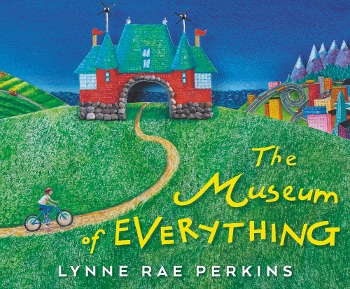The art in Lynne Rae Perkins’s joyfully curious picture book The Museum of Everything, with its vivid colors and alluring assortment of bits and pieces, celebrates curation, creation, and the private life of the mind.
 The art in Lynne Rae Perkins’s joyfully curious picture book The Museum of Everything, with its vivid colors and alluring assortment of bits and pieces, celebrates curation, creation, and the private life of the mind.
The art in Lynne Rae Perkins’s joyfully curious picture book The Museum of Everything, with its vivid colors and alluring assortment of bits and pieces, celebrates curation, creation, and the private life of the mind.
The dust jacket depicts the landscape around an imagined museum — Is that the sun, the moon, or a small lightbulb in the sky? —while the cover art underneath shows a collection of objects (a rubber band, a rock, a cherry tomato). Bright yellow endpapers bookend the story in warmth.
On the title page, a chalky outline of a hand grips the handle of a brightly colored door, enticing us to turn the page and enter. This outlined figure reappears throughout the book, providing another entry point for readers to engage with the art. The next page features a photographed miniature museum exhibit, wordless and reverent, secured with tiny velvet (pipe cleaner?) rope and stanchions. What is on exhibit? A dandelion? A crispy, fallen leaf? A break in the stanchions suggests we could get closer.
The first-person narrative picks up on the following page, and the style of the art shifts. The page is still a compilation of pieces but now mostly in cut-paper collage with drawn elements. “When the world gets too big and too loud and too busy, I like to look at little pieces of it, one at a time.”
Whether they realize it or not, children are often curating and cataloging their own tiny museums. Sometimes you can find exhibits in their pockets or drawers and on windowsills and shelves. Rocks, shells, dried plants, dead insects, live insects, scraps of paper — they take these and study them, organize them, care for them, and display them. The world seems big, and this is how we sort it out. Taking the time to notice, smell, taste, touch, and gather helps us make sense of things.
Thus the style of illustration for this "story-line, theme, or concept,” per the Caldecott criteria, could not be more appropriate here. Collage by its definition is an ingenious technique for creating a museum-themed picture book — both are layered collections of pieces that form a whole and tell a story. When Perkins’s child narrator wonders how passing thoughts and discoveries might fit into a museum, the collaged spreads and spot art are created in an illustrated style that deftly morphs into a tangible diorama collage when showcasing the created exhibits. That fluid change in style allows readers to absorb and probe the stream-of-consciousness musing of the narrator and realize possibilities as we move from a Museum of Islands to a Museum of Hiding Places, a Museum of Shadows, and a Sky Museum.
Perkins provides an artist’s note at the end of the book: “The art in this book was made of watercolor on (Arches® 300lb cold press) watercolor paper, sometimes cut and/or folded along with sand, stones, twigs, wood, moss, wool, foamcore board, fabric, embroidery thread, modeling clay, lights, two tiny clay figures made by Marcia Hovland, and many, many, many odds and ends. It was the most fun ever.”
Indeed, the illustrations look like they were the most fun ever, and readers who like to create may want to try making their own. I know I did.
This is a book to be taken slowly. The placement of shapes and lines on the page expertly sets the pace. The arc of a line might prompt the reader to turn some pages but spend more time on others. Often the layout forces the eye to pause or even look from right to left. Perkins’s marvelous use of light, shadow, color, and texture, executed with layers of paper and objects, is immediately striking, but, as in any museum, the longer one looks, the more one finds to notice.
Perkins’s book gives visual permission to slow down and explore, prod, and imagine. I love how the intricate art in this book encourages readers to look and play with the ideas posed and then expand on them. It can be inspiring to visit a museum, but it can be even more inspiring to recognize the museum we build in our heads and in the spaces around us as we make connections from one bit to the next. I wonder what this year’s committee is noticing — there is so much in the art of this thought-provoking book worthy of deep discussion.
[Read the Horn Book Magazine review of The Museum of Everything.]

ALREADY A SUBSCRIBER? LOG IN
We are currently offering this content for free. Sign up now to activate your personal profile, where you can save articles for future viewing.








Add Comment :-
Be the first reader to comment.
Comment Policy:
Comment should not be empty !!!